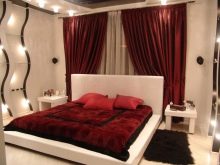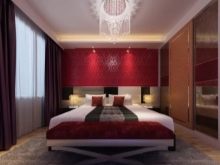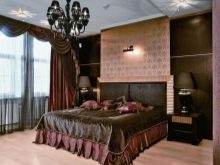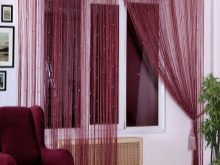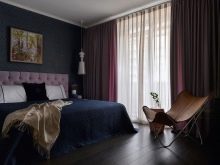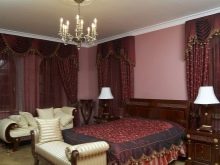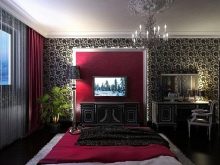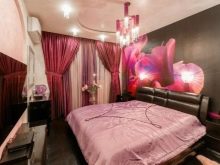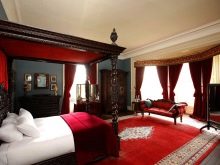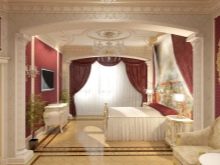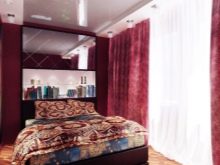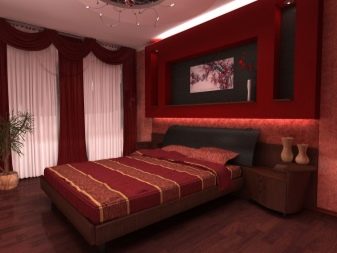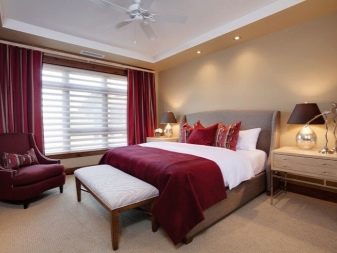Burgundy curtains in the bedroom interior
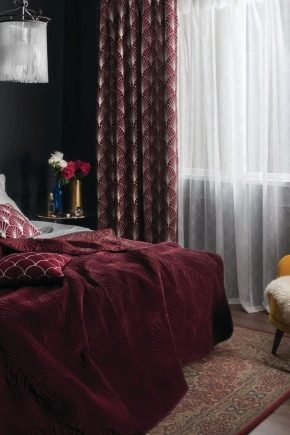
Without curtains, the bedroom looks uncomfortable and empty. After all, the bedroom is the very place where a person wants to feel relaxed and calm. Let's figure out how relevant burgundy shades are in a modern bedroom interior, and also consider how to choose the right burgundy curtains.
Views
The most common version of curtains in a bedroom is classic thick curtains and tulle included. Often this combination is complemented by some kind of lambrequin. But the modern variety of different materials allows you to show your imagination and create a unique interior.
What types of curtains you can choose for the bedroom depends on many factors:
-
the size of the room;
-
illumination and orientation of windows to the cardinal points;
-
furniture and general style;
-
age and interests of the person living in this room and more.
The type of curtains also depends on what fabric they are made of. So, dense heavy materials, for example, velvet, velor, are intended for curtains of a simple form, without any frills in the form of frills, ruffles. The most that can be offered for them is eyelets or loops from the same fabric, or light drapery, and you can also add them with clamps or clamps.
From light thin fabrics (muslin, chintz, silk), airy flying curtains are created with many different details, thick drapery, with braid, ribbons and other all kinds of accessories.
To create strict simple forms such as Japanese or Roman curtains, you will need fabrics such as linen, cotton, gabardine, taffeta.
Popular shades
Burgundy is the color of luxury and wealth. It has characteristics such as strength, confidence, originality, creativity, as well as aggression.
Of course, for the bedroom, this color should be used in very moderate doses.
But burgundy, like any other color, has a very large number of shades, both warm and cold:
-
cherry;
-
Bordeaux;
-
eggplant;
-
Marsala;
-
pomegranate;
-
Red tree;
-
maroon and others.
If you choose the right shade correctly, combine it correctly with the rest of the interior details, then it is the burgundy curtains that can decorate the bedroom.
Design
The design of window openings is inseparable from the overall design of the bedroom. For example, if the interior is conceived in an oriental style, then the curtains can be sewn from heavy velvet, with fringe, with gold trim, tassels, and such curtains can completely cover the windows, and the burgundy color should be used in additional accessories, cushions, ottomans. At the same time, it is desirable that such a bedroom be spacious, with a sufficient amount of natural light, otherwise the abundance of burgundy color will create a heavy oppressive atmosphere in the room.
Alternatively, in this case, these are additional lamps.
And also the main burgundy color of curtains is also suitable for creating empire, baroque, classic styles.
For such design directions as minimalism, art deco, modern, burgundy can be used as various patterns, blotches on a light background of fabric. Stripes, various geometric patterns, ornaments will look good. In this case, heavy fabrics can be replaced with lighter ones, or only tulle can be used.
How to choose the interior?
As already noted, burgundy color is considered luxurious, royal, because it was not without reason that it was used earlier in the design of palaces. But if in the huge royal chambers it looks very organic, then for small bedrooms in modern houses, burgundy curtains have to be carefully selected to match the existing interior.
In the bedroom with light wallpaper and large windows, thick curtains will create an atmosphere of comfort and tranquility, because a sound sleep requires the absence of light sources. And burgundy curtains look good with solid dark wood furniture.
You should always remember about a reasonable combination of shades of walls, furniture, curtains and other small details of the furnishings among themselves.
The main rule of designers: the interior should not contain more than 3 colors, and they should be correlated in the proportions of 60: 30: 10.
The main color in the room is assigned 60%. These can be either walls and ceilings, or floors, or curtains if they occupy the entire window opening. Complementary tones are 30% of the surface. The remaining 10% are accents, decor.


